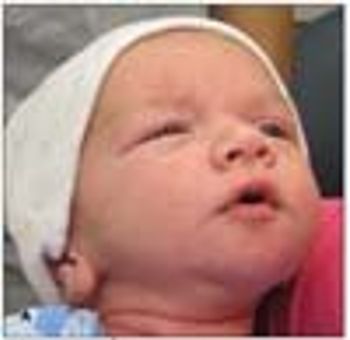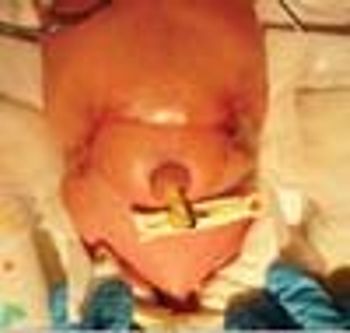
A 4-week-old boy with tactile fever for the past 24 hours and fussiness of 2 weeks' duration is referred to the emergency department (ED).

A 4-week-old boy with tactile fever for the past 24 hours and fussiness of 2 weeks' duration is referred to the emergency department (ED).

This 1-week-old baby boy was brought for his first newborn visit. The parents were concerned that when he cried, the left side of his face “does not move.”

A baby boy born after normal vaginal delivery at 36 weeks’ gestation was noted to have a distinct abdominal wall lesion. Apgar scores were 8 and 9 at 1 and 5 minutes, respectively.

Shining light on the debate : What the IOM recommendations really mean for your patients Social networks and cyber bullies : What are your patients telling you? Preventing neonatal pertussis through maternal immunization Dermcase : Streptococcal infection and psoriasis Puzzler : Headache, swollen forehead in 4-year-old Updates : HPV vaccine, Children with medical complexity, Retinopathy of prematurity, Consumer product safety commission

Children who are medically fragile and have the most intensive health care needs demand a focused approach to meet their multiple clinical and family-focused needs.

There is going to be extensive discussion in Congress this year on how and how strictly to regulate consumer products for child safety.

What do the new resident work hour restrictions have in common with the medical home concept? Both require teamwork-acknowledgement of a shared responsibillity for the health and well-being of each patient.

How concerned should you be about vitamin D deficiency in your patients? Here are the findings and recommendations of the 2011 IOM report.

Dr Michael G Burke submits his Top 10 list of favorite articles in the last 12 months.

Pediatricians should be offering advice about ultraviolet radiation exposure at 1 or more health-maintenance visits a year beginning in infancy.

The parents of a 4-year-old boy complain that he has developed a frightening, rapidly progressive skin rash over the course of 3 days.

A 4-year-old boy presents to your office one day with his mom and dad, with a 6-month history of headaches and recent appearance of a tender lump in the middle of his forehead.

According to study results out of Norway, paracetamol, or acetaminophen, exposure in pregnancy and in infancy is associated with a child's allergic disease at the age of 10 years.

Youth spend up to 10 hours a day using a wide variety of media, including computers.

Many sources of child care information, such as pediatricians, mothers, other family members, friends, the Internet, TV and newspapers, and parenting books, are available to parents.

Intravitreal injection of bevacizumab proved superior to conventional laser therapy for preventing recurrence of retinopathy of prematurity while averting many of the complications of laser treatment.

The recombinant human papillomavirus quadrivalent (types 6, 11, 16, and 18) vaccine was effective at preventing genital warts in men 16 to 26 years old in phase 3 student results published in the New England Journal of Medicine.

The site offers guidance on key topics encountered in clinical practice, as well as short, quick-reading features that emphasize diagnostic quizzes, fast solutions, and color photography. We also offer point-of-care diagnostic help with PhotoClinic Mobile, our app that helps physicians pin-point diagnosis and treatment of common conditions. Or, find the latest research, guidelines, and peer reviewed publications in the pediatrics channel of SearchMedica.com. Physicians, we'd love to hear from you. Add your comments to the site and get regular e-mail updates with a quick registration. Send us original case reports accompanied by outstanding images and that have a practical teaching message for primary care practitioners. Please refer to our Author Guidelines for information on style and format. Cases can be submitted to the Editorial Team at editor@consultantlive.com. Or, just let us know what gets your goat and keeps you up at night.

Kirk Barber, MD, FRCPC Clinical Associate Professor, Departments of Medicine and Community Health Sciences, University of Calgary, AlbertaJohn W. Harrington, MD Associate Professor of Pediatrics, Eastern Virginia Medical School, The Children's Hospital of The King's Daughters, Norfolk, Virginia Gregory F. Hayden, MD Professor of Pediatrics, University of Virginia School of Medicine, Charlottesville, Virginia Deepak M. Kamat, MD, PhDProfessor of Pediatrics, Wayne State University School of Medicine, Vice Chair of Education, Children's Hospital of Michigan, Detroit Alexander K. C. Leung, MD Clinical Associate Professor of Pediatrics, University of Calgary, Pediatric Consultant, Alberta Children's Hospital, Calgary, Alberta Prashant V. Mahajan, MD, MPH, MBAAssociate Professor, Departments of Pediatrics and Emergency Medicine, Wayne State University School of Medicine, Children’s Hospital of Michigan, DetroitLinda S. Nield, MD Associate Professor of Pediatrics, West Virginia University School of Medicine, Morgantown, West VirginiaCharles A. Pohl, MD Professor of Pediatrics, Associate Dean for Student Affairs and Career Counseling, Jefferson Medical College of Thomas Jefferson University, Philadelphia Wm. Lane M. Robson, MD Medical Director, The Childrens Clinic Calgary, Alberta Edward J. Shahady, MD Clinical Professor of Family Medicine, University of Miami, Associate Faculty, Tallahassee Memorial Family Practice Residency Medical Director, Diabetes Master Clinician Program of the Florida Academy of Family Physicians Foundation, Jacksonville, Florida Russell W. Steele, MD Division Head, Pediatric Infectious Diseases, Ochsner Children's Health Center, Clinical Professor of Pediatrics, Tulane University School of Medicine, New Orleans Golder N. Wilson, MD, PhDClinical Professor of Pediatrics, Texas Tech University Health Sciences Center, Amarillo, KinderGenome Pediatric Genetics, Dallas

Robert P. Blereau, MD Family Medicine, Morgan City, LouisianaMichael S. Heitler, MD Clinical Professor of Pediatrics, New York University School of Medicine, New YorkDavid L. Kaplan, MD Clinical Assistant Professor of Dermatology, University of Missouri Kansas City School of Medicine, Overland Park, KansasJoseph A. Lieberman III, MD, MPH Professor of Family Medicine, Jefferson Medical College, Philadelphia

SUBMISSION GUIDELINESTo submit case reports with accompanying images, contact:Email: editor@consultantlive.com.READER FEEDBACKFor general questions/comments, contact:Email: susan.kweskin@ubm.com





A review from the Cochrane Library validates the use of nebulized epinephrine (NE) to quickly relieve symptoms of moderate to severe croup in children.

Energy drinks can have serious adverse effects in children, adolescents, and young adults, those who are large consumers of these beverages.

Preadolescents with type 1 diabetes may have endothelial dysfunction and systemic inflammation, precursors of future cardiovascular risk, new findings suggest.

Risk factor clustering is a simple, reliable tool that clinicians can use to detect cardiovascular (CV) disease in youth, according to a study published online in Pediatrics.

• ADHD • Allergy • Asthma • Atopic Dermatitis • Autism • Bacterial Conjunctivitis • Developmental/Genetic Disorders • Epilepsy • Failure to Thrive • Food Allergies • GI Disorders • Lice Treatments • Obesity • Respiratory Tract Diseases • Sexually Transmitted Infections • Skin Diseases • Vaccines • Vitamin D Insufficiency